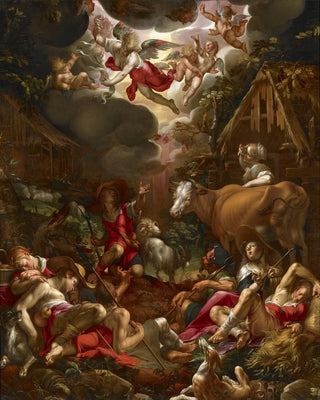Art print | Annunciation to the Shepherds - Joachim Wtewael


View from behind

Frame (optional)
The artwork "Annunciation to the Shepherds" by Joachim Wtewael, created in the early 17th century, exemplifies the Flemish Baroque style characterized by its dynamism and rich chromatic palette. This painting, depicting a pivotal moment in biblical narration, transports viewers into a scene filled with mystery and spirituality. The composition is both narrative and symbolic, revealing the depth of human emotions in the face of the divine event. As you contemplate this piece, you are immediately struck by the intensity of the characters' expressions, which seem to capture a suspended moment between the ordinary and the sacred.
Style and uniqueness of the artwork
Wtewael stands out for his distinctive approach to chiaroscuro, a technique that emphasizes the contrast between light and shadow, giving his figures a striking three-dimensionality. In "Annunciation to the Shepherds," vibrant colors—from deep reds to dazzling golds—create an atmosphere that is both warm and solemn. The scene, where astonished shepherds receive the announcement of Christ's birth, is bathed in a divine light emanating from the central figure, the angel. The meticulous details, whether in the drapery of the garments or in the facial expressions, demonstrate careful attention to every element of the composition. This focus on fine details, combined with powerful visual storytelling, makes this work a true ode to the beauty of the sacred moment.
The artist and his influence
Joachim Wtewael, born in 1566 in Utrecht, is a prominent figure in Dutch art. His artistic journey, influenced by various sources, notably Italy, allowed him to develop a distinctive style that combines technical precision with palpable expressiveness. Wtewael captured the essence of his subjects, whether mythological or religious, breathing new life into classical stories. His impact on his contemporaries and subsequent generations is undeniable, as he paved the way for a more dramatic and emotional approach to painting. By redefining the

Matte finish

View from behind

Frame (optional)
The artwork "Annunciation to the Shepherds" by Joachim Wtewael, created in the early 17th century, exemplifies the Flemish Baroque style characterized by its dynamism and rich chromatic palette. This painting, depicting a pivotal moment in biblical narration, transports viewers into a scene filled with mystery and spirituality. The composition is both narrative and symbolic, revealing the depth of human emotions in the face of the divine event. As you contemplate this piece, you are immediately struck by the intensity of the characters' expressions, which seem to capture a suspended moment between the ordinary and the sacred.
Style and uniqueness of the artwork
Wtewael stands out for his distinctive approach to chiaroscuro, a technique that emphasizes the contrast between light and shadow, giving his figures a striking three-dimensionality. In "Annunciation to the Shepherds," vibrant colors—from deep reds to dazzling golds—create an atmosphere that is both warm and solemn. The scene, where astonished shepherds receive the announcement of Christ's birth, is bathed in a divine light emanating from the central figure, the angel. The meticulous details, whether in the drapery of the garments or in the facial expressions, demonstrate careful attention to every element of the composition. This focus on fine details, combined with powerful visual storytelling, makes this work a true ode to the beauty of the sacred moment.
The artist and his influence
Joachim Wtewael, born in 1566 in Utrecht, is a prominent figure in Dutch art. His artistic journey, influenced by various sources, notably Italy, allowed him to develop a distinctive style that combines technical precision with palpable expressiveness. Wtewael captured the essence of his subjects, whether mythological or religious, breathing new life into classical stories. His impact on his contemporaries and subsequent generations is undeniable, as he paved the way for a more dramatic and emotional approach to painting. By redefining the






